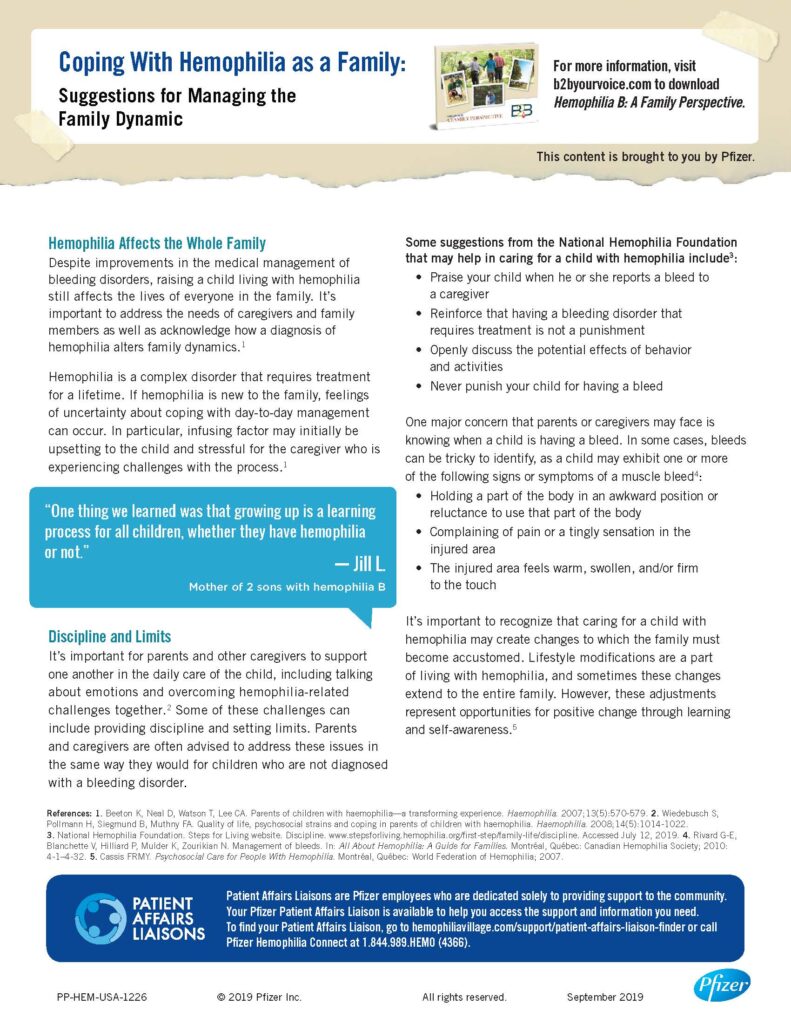admin
Young Adults and Insurance
This is a paid public announcement from Pfizer and does not constitute an endorsement of products or services. When you click on the links in this blog entry, you will be directed to a Pfizer website. LA Kelley Communications always advises you to be a savvy consumer when contacting any company; do not reveal identifying information against your will.

Making healthy habits stick, with help from BleedingDisorders.com
This is a paid public announcement from Takeda and does not constitute an endorsement of products or services. When you click on the links in this blog entry, you will be directed to the Takeda website. LA Kelley Communications always advises you to be a savvy consumer when contacting any company; do not reveal identifying information against your will.
With everything that life throws at you, it’s not always easy to make healthy habits stick. But for people with a bleeding disorder, diet and exercise are two important ways you can help keep your body—and especially your joints—healthy.1,2
Here are a few quick tips from BleedingDisorders.com that could help you maintain a healthy weight and prevent joint damage.
Eating right and staying strong
An apple a day might not actually keep the doctor away, but eating right is a key element of living a healthy lifestyle. And that might be even more true for people living with bleeding disorders.1
While there isn’t a special diet recommendation for people with bleeding disorders, many of the same guidelines from the USDA apply: more fruits and veggies, less solid fat and sugar.3 But that doesn’t mean you can’t eat the foods you love. Try looking up new recipes that include more healthy ingredients. Cauliflower pizza crust might be your new weeknight favorite!
You can get more info about healthy eating habits at BleedingDisorders.com. And before starting any diet, remember to check with your healthcare provider (HCP) or Hemophilia Treatment Center (HTC).

To keep your body healthy, keep it moving
Exercise is another key aspect of maintaining joint health and staying at a healthy weight.2 While people with bleeding disorders used to be discouraged from participating in sports, modern treatment means that many people can continue to be physically active. In fact, it’s encouraged.2,4
Keep in mind that not all physical activities may be safe for you to do. The National Hemophilia Foundation’s Playing It Safe pamphlet includes a helpful list of physical activities and the level of risk associated with them.4 Here are some examples of low- and high-risk activities.

This is another area where it’s important to talk with your HCP or get in touch with a Hemophilia Treatment Center before getting started. And if you want more info about different types of exercises and how they may help you, check out BleedingDisorders.com.
Stay connected
Feeling inspired to making some healthier life choices? Your first step might be to get in touch with your Hemophilia Treatment Center, where you can get expert advice about managing a bleeding disorder. Your healthcare provider team can also help with any questions about diet and exercise. And of course, connect with the Bleeding Disorders community on Facebook, Instagram, YouTube, and Twitter, and sign up to get the latest news and updates.
References:
- Thomas Smith K. Weighty matters. HemAware website. January 30, 2015. Accessed January 27, 2021. https://hemaware.org/mind-body/weighty-matters
- Goto M, Takedani H, Yokota K, Haga N. Strategies to encourage physical activity in patients with hemophilia to improve quality of life. J Blood Med. 2016;7:85-98.
- U.S. Department of Agriculture and U.S. Department of Health and Human Services. Dietary guidelines for Americans 2010. December 2010. Accessed January 27, 2021. https://health.gov/dietaryguidelines/dga2010/dietaryguidelines2010.pdf
- Playing it safe: bleeding disorders, sports and exercise. National Hemophilia Foundation. 2017. Accessed January 27, 2021. https://www.hemophilia.org/sites/default/files/document/files/playing-it-safe_0.pdf

Copyright © 2021 Takeda Pharmaceutical Company Limited. Lexington, MA 02421. 1-800-828-2088. All rights reserved. TAKEDA and the TAKEDA logo are trademarks or registered trademarks of Takeda Pharmaceutical Company Limited.
[US-NON-4339v1.0 02/21]
From starting school to starting young adult life, BleedingDisorders.com can help at every mile of the journey
Our publications address the many challenges you face as you reach new milestones in life with hemophilia. For this week’s HemaBlog, we suggest you check out this website to learn more about handling life’s many phases and changes!
This is a paid public announcement from Takeda and does not constitute an endorsement of products or services. When you click on the links in this blog entry, you will be directed to a Takeda website. LA Kelley Communications always advises you to be a savvy consumer when contacting any company; do not reveal identifying information against your will.
 Every life has its twists and turns, and that’s even more true for young people with bleeding disorders and their caretakers. BleedingDisorders.com is right there with you through every mile of the journey, with info and resources designed to help you and your family navigate change—whether that means your child’s first day of school or their last day living at home.
Every life has its twists and turns, and that’s even more true for young people with bleeding disorders and their caretakers. BleedingDisorders.com is right there with you through every mile of the journey, with info and resources designed to help you and your family navigate change—whether that means your child’s first day of school or their last day living at home.
As school is getting underway, get the team together
Starting school is a big step—for you and your child! To make it as safe as possible, it’s a good idea to go over some important topics with key members of your school team, including your child’s teacher, the school nurse, the guidance counselor, the gym teacher, and someone from administration.1 You play an important role in educating them about your child’s bleeding disorder and what they should expect with your child under their supervision. And of course, this meeting can be virtual or in-person, depending on your school’s situation.
Wondering what other topics you should cover with your ace team of educators? Bleedingdisorders.com has put together a helpful list.
Growing up and taking control
Young adulthood is another important transitional period for people living with a bleeding disorder. For some, it might be the first time in their life they are responsible for managing their treatment and their symptoms on their own. And whether they are moving into a college dorm or just moving out, you and your child should make sure you’re both prepared for the transition.
Here are a couple key tips for your family that could help make the move go smoother:
Prep for an Emergency
With hemophilia, a bleeding emergency can come at any time. Preparing an Emergency Care Letter and an emergency bag with everything they’ll need can save time and stress.2
Ace Your Storage Quiz
Make sure they know exactly how to store and handle their treatment. Products that have been improperly stored or have expired may not be as effective in preventing or treating bleeding episodes.3
See the full list of helpful tips for young adults at BleedingDisorders.com.
No matter what life stage you or your child is at, it’s important to have a good relationship with your local Hemophilia Treatment Center, where you can get expert advice about managing a bleeding disorder. Your healthcare provider team can also help with any big life changes your family may face. And of course, connect with the Bleeding Disorders community on Facebook, Instagram, YouTube, and Twitter, and sign up to get the latest news and updates.
- Phyllis McIntosh; HemAware. Back to school. 2006. Accessed September 14, 2020. https://www.hemophiliafed.org/uploads/Back-to-School_Hemaware.pdf
- Emergency preparedness. Steps for Living website. Accessed September 14, 2020. https://stepsforliving.hemophilia.org/step-up/treatment/emergency-preparedness
- Frase M. Safely storing factor at home. HemAware website. June 21, 2010. Accessed September 14, 2020. https://hemaware.org/bleeding-disorders-z/safely-storing-factor-home

Copyright © 2020 Takeda Pharmaceutical Company Limited. Lexington, MA 02421. 1-800-828-2088. All rights reserved. TAKEDA and the TAKEDA logo are trademarks or registered trademarks of Takeda Pharmaceutical Company Limited.
US-NON-2287v1.0 09/20




